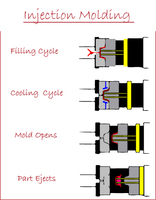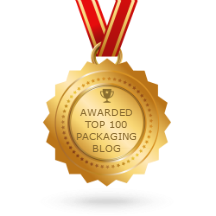 Loading... Please wait...
Loading... Please wait...Blog - Injection Molding Manufacturer
How are Plastic Jars made? - Injection Molding vs. Blow Molding - Plastic Jar Manufacturing
Posted by Linda Thell on 10-12-2016

Blow-molded jars or injection-molded jars, that is the question. If you are undecided, like many undecided voters out there today, then this comparison on plastic jar manufacturing processes might help you out. Plastic Jars are either Blow Molded or Injection Molded. If you've done your research, you probably know that Injection molded jars mean materials in Polypropylene (PP), and Polystyrene (PS); Whereas, blow-molded jars rule the market of PETE (PET) and HDPE materials. This article isn't necessary dedicated to materials though, it's rather focused on the processing of the two different jar manufacturing techniques.
It's important to know the difference between the different methods of plastic jar manufacturing if you are sourcing plastic jars. You may ask: why? Well, because, knowing the difference could save you both time and money in your packaging design, prototyping and production for your packaging. Knowing the difference between blow molding and injection molding can be beneficial if you are undecided on which type of plastic jar manufacturer you want to work with, or if you are undecided on which plastic jars to try when sampling jars, containers and closures for your packaging. Parkway Plastics Inc. will let you sample Injection Molded PP Caps, PP and PS Jars, and Blow molded PETE plastic jars. So, whatever you decide is best for your product and your business, Parkway can help you with either Blow-Molded or Injection Molded Plastic Jars, Containers and Packaging.
In this blog post, I intend to explain the differences between Blow Molding and Injection Molding, two very common industrial manufacturing techniques in plastics:
Injection Molding VS. Blow Molding
- Injection Molding and Blow Molding (BrE. moulding) are both very common plastic manufacturing processes for producing high volume plastic parts in a fast manner.
- Blow molded jars are very light weight in contrast to Injection molded jars, such as Parkway's Regular Wall or Thick Wall Jars.
- One difference is that the injection molding machine creates solid parts; whereas, the blow molding machines also can produce hollow parts, such as water bottles.
- The thickness of the part really differentiates these two types of production. Injection molding manufacturers can produce plastic parts for rigid walls. You would get a more flexible jar if you go with a blow molder. This has to do with both the production process and the plastic material.
Injection Molding Manufacturing:
1.Tool: Mold
2. 90% of time is needed on the job is spent on creating the Mold
3. Plastic material is melted and injected into the mold, after cooling the component is ejected from the mold.
4. Process - Cyclic (each time mold is filled, cooled and component is ejected)
5. Air is a concern in the injected plastic
Blow Molding Manufacturing:
1. Tool: Die
2. 50% of the time spent on the job is needed for making the mold.
3. Plastic material is melted and pressurized into the die and the out coming profile or extrudate is cooled.
4. Process - Continuous (extrudate comes out of the die in a continuous manner).
5. Air is needed to force the plastic to expand
Comments:
The setup-cost, part-cost, and production time is pretty similar to each other. However, the tooling and setup-cost for injection molding productions can be higher than for example a Extrusion Blow Molding Production. Injection molding setup usually requires more effort from engineers in creating the mold for production because each mold must be specially designed for each specific plastic part (or jar) to be manufactured. At Parkway, this is done with precise care. Because of this, Parkway and other Plastic Jar Manufacturers often run injection molded jars in high quantities and volumes. This is consequently one of the reasons why Parkway Plastics also stock such a large inventory quantities of injection molded PP and PS plastic jars, lids, and containers.
One concern people may have can be that the blow molded jars aren't thick enough. If this concern is present to you, explore the thicker injection molded jars here.
Choosing to go with an injection molding manufacturer is very beneficial for the business owner or product developer who needs to order high quantities or volumes of jars.
Plastic jars, containers, and bottles:
Jars in PETE and HDPE materials are mainly Blow Molded; whereas, PP and PS Jars usually are Injection Molded. However, High-density polyethylene (HDPE) is a polyethylene thermoplastic made from petroleum, and this thermoplastic can also be injection molded as it melts at a certain temperature (the definition of a thermoplastic). Learn more about custom materials here. Parkway Plastics is an injection mop plastic jar manufacturer who specializes in injection molded plastic jars. With hundreds of different molds and cavities, Parkway Plastics can help mold your jar, and manufacture your plastic container, lid or cap. The blow molded process allows for a very thin mouth opening of bottles, which is why all bottles are blow molded.
Blow Molded Products & Injection Molded Products
Injection molding and blow molding are two common and widely used plastic manufacturing techniques.
Blow Molded Product Examples:
|
Injection Molded Product Examples:
FUN SIDE NOTE: Injection molded plastic parts include Automotive Dashboards, Bumpers, and components inside cars, such as buttons on the radio, and buttons for automated windows. Parkway Plastics' injection molded PP or PS jars are perfect for storage of these injection molded automotive parts, so you can stay organized in the automotive industry. Learn more here.
READ ABOUT BLOW MOLDING : Blow Molding Explained - How PET Jars and Containers are Manufactured!
We love to help you and your company with both injection molded, and blow molded Jars, Containers and Packaging. Start sampling our injection molded PP, PS containers and our blow molded PETE (PET) Jars today! Start Here.
READ ABOUT INJECTION MOLDING: Injection Molding Explained - How PP and PS Jars and Containers are Manufactured
Ref.
http://moldedparts.com/2015/04/difference-between-...
http://www.rdmolders.com/blog/the-differences-betw...

Injection Molding Explained - How PP and PS Jars and Containers are Manufactured - How Parkway Plastics Manufacture Plastic Jars
The injection molding process was first established in the 1930s. Injection molding is today one of the best processes for producing solid and durable plastic jars. Polypropylene (PP) is a common thermoplastic material used in injection molding. Another thermoplastic that is commonly used is Polystyrene. These thermoplastics are often used across the world for the [...]
Recent Posts
- » Buy Custom Plastic Jars Direct from Manufacturer - Parkway Plastics
- » California Packaging Regulations and You! How does Parkway stack up? Parkway Plastics Meets CA Rigid Plastic Packaging Container Laws!
- » Blow Molding Explained - How PET Jars and Containers are Manufactured!
- » How Reusable Packaging Can Help Improve Your Brand Image & Costs | Safe Plastic Jars for Reuse | Optimize Your Supply Chain with Reusable Plastic Jars and Packaging |
- » Parkway Now Offers Child Resistant Closures | CRC |

